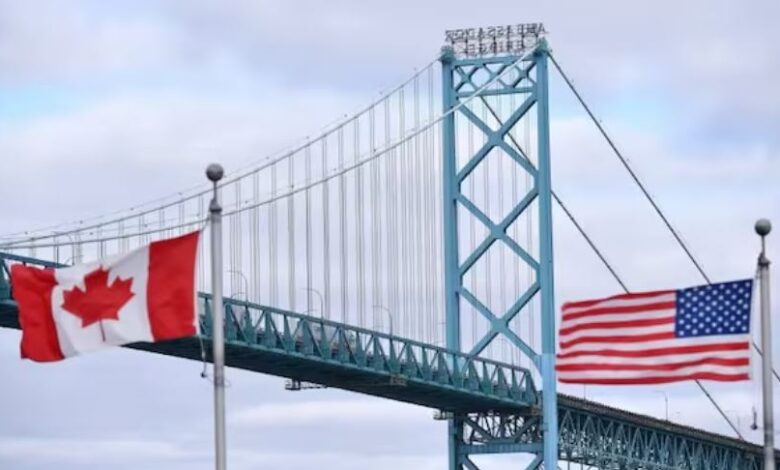What the end of a U.S. COVID-19 border restriction could mean for Canada

Title 42 ended Thursday and the Biden administration is bringing in new border and asylum measures
The United States lifted a pandemic border control policy late Thursday — a move that could have implications for Canada’s approach to migrants and asylum seekers.
The Trump administration invoked Title 42 shortly after the COVID-19 pandemic started in March 2020. The policy, which is part of the 1944 Public Health Service Act, allows American border authorities to quickly turn back migrants, including asylum seekers, at Ports of Entry (POE) to prevent the spread of disease.
There is a serious danger of the introduction of COVID-19 into the land POEs and border patrol stations at or near the United States borders with Canada or Mexico, and into the interior of the country as a whole,
Dr. Robert R. Redfield, then director of the Centers for Disease Control, said in the 2020 order (new window).
The Biden administration attempted to terminate Title 42 in 2022 but court decisions kept it in place. The order officially expired at 11:59 p.m. ET Thursday.
According to United States Customs and Border Protection (CBP) statistics (new window), the United States Border Patrol expelled just over a million migrants between October 2021 and September 2022 under Title 42. It expelled 85,672 migrants in March of this year alone, the latest month for which statistics are available.
A CBP spokesperson did not answer the question when CBC News asked how many of the expelled migrants came from Canada.
The White House has introduced new border enforcement measures (new window) which will maintain expedited removal for migrants who attempt to enter the United States unlawfully.
Migrants and asylum seekers in north and central Mexico now have to use an app to fill out a form prior to arriving in the United States. The Biden administration also has said it will put more resources into anti-smuggling efforts in response to Title 42’s expiration.
Luisa Veronis, a geography professor at the University of Ottawa, said smugglers often spread misinformation about changes in border policies in an effort to increase business. She said the United States and Canada could respond by providing more information about what the recent changes actually mean.
I think that’s another point where both Canada and the U.S. could control … making the information accessible, digestible. I think that would be a way to at least make people aware of what is really going on,
Veronis said.
The Immigration and Refugee Board of Canada assessed 45,444 refugee claims in 2022, according to board statistics (new window). The Canada Border Services Agency (CBSA) and Immigration, Refugees, and Citizenship Canada (IRCC) report that 91,870 asylum claimants came to Canada last year (new window).
Though Veronis is critical of the United States government’s approach to asylum seekers, she said it’s notable that the U.S. is using the expiry of a pandemic restriction as an opportunity to take a new approach to the problem. She said Canada could learn from that effort to address an influx of asylum seekers.
The U.S. is trying to put in place practical ways for people to claim asylum by creating an app,
Veronis said.
So maybe this is a good time to find legal pathways … We need to come up with a smart solution.
New American border policy harsher: refugee lawyer
Aviva Basman, the president of the Canadian Association of Refugee Lawyers (CARL), said the Biden administration’s new approach to the border is even harsher than Title 42.
“What’s being replaced after Title 42 is something a lot worse. The new rule is more restrictive, more expansive, and it will be barring asylum seekers from seeking protection in the United States,” she said.
This is going to substantially restrict accessibility to the border. There’s been a lot of problems reported with this app and its use.
Title 42’s expiration comes just a few months after Canada and the United States renegotiated the Safe Third Country Agreement (new window). The new, expanded version of the agreement closed a loophole which allowed migrants to make asylum claims in Canada if they arrived from the United States between official POEs.
Earlier this year, a family of four Indian nationals and a family of Romanian descent died near the Canada-United States border. (new window) Police in Canada say they believe they were trying to enter the United States from Canada through Akwesasne Mohawk Territory.
Basman said CARL fears that more asylum seekers, including those headed for the United States via Canada, could seek more dangerous methods of crossing the border.
Individuals are going to feel forced to take more and more desperate, perilous routes in order to access asylum,
she said.
As part of the deal that renegotiated the Safe Third Country Agreement, Canada agreed to take 15,000 migrants from the Western Hemisphere.
Basman said she hopes Canada responds to the changes in United States border policy by opening itself up more to asylum seekers.
I think that it’s really just important to think about this from the perspective of Canada’s obligations, and what this means for Canada’s reputation as a country that provides protection to refugee claimants who arrive,
she said.
What we’re really hoping now is that Canada will provide increased access to its asylum procedures by putting in place different categories of exemptions that take into account some of the gaps in the U.S. asylum system.
Richard Raycraft · CBC News with files from Benjamin Shingler and the Associated Press




